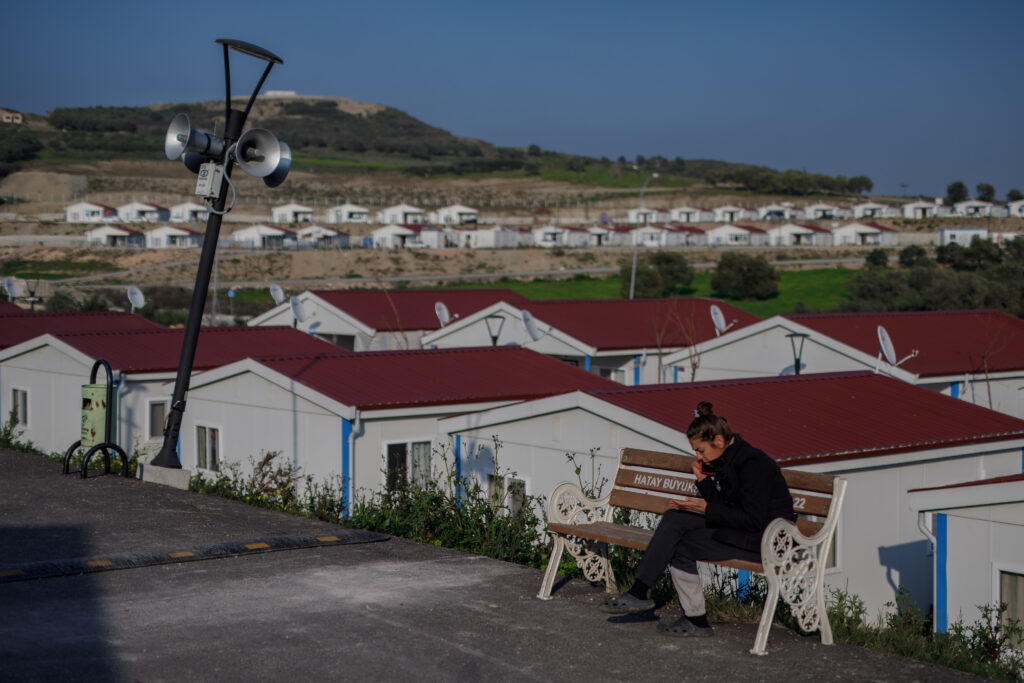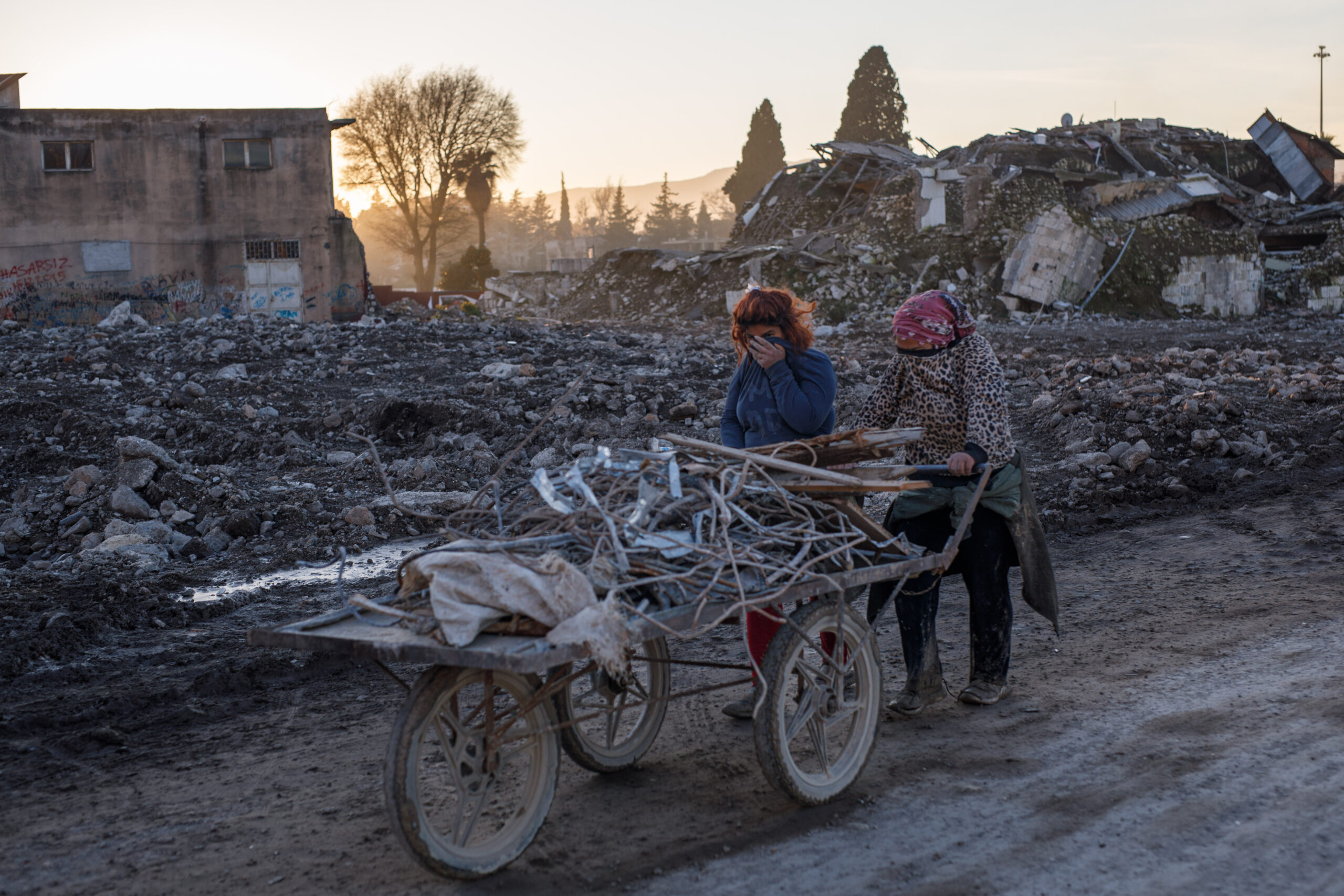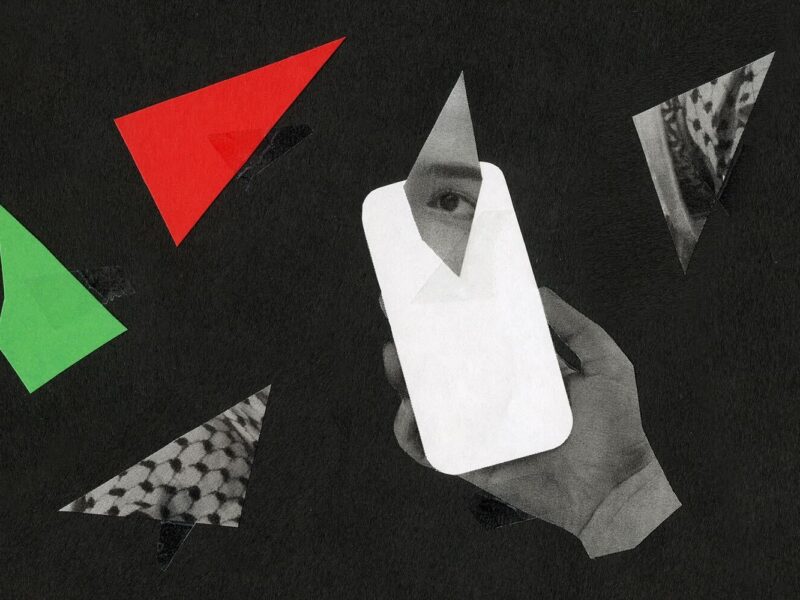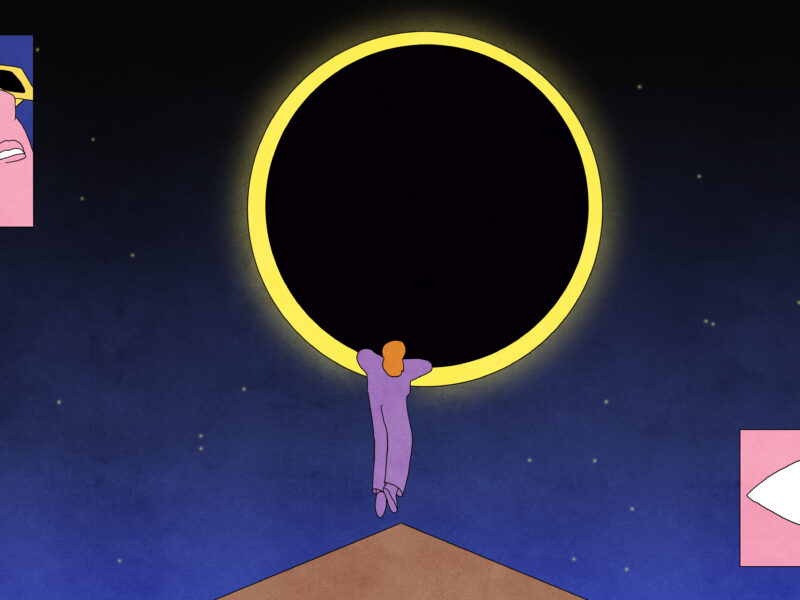Women from one of Turkey’s most affected regions share how little has changed—and how much still needs to be done.
Inside a prefabricated house atop a hill in Antakya, Turkey, Saniye Yılmaz is sitting on a beige velvet sofa, charging the beeping pill installed in her heart. She is shaking, and struggles to speak.
“Everything got worse after the earthquake,” she says, adding that the stress has made the symptoms of her Parkinson’s disease even more unbearable. “We’re the living dead.”
It’s been over a year since the Hatay region of Turkey, where she lives, faced a colossal trauma: On February 6, 2023, two catastrophic earthquakes initiated the collapse of over 160,000 buildings across 11 provinces in Turkey’s south and southeast, killing more than 50,000 people, injuring more than 107,000, and directly impacting over 13 million. The two earthquakes—with a magnitude of 7.8 and 7.5, respectively—happened only nine hours apart, with many aftershocks in between and after.
Shortly following, ahead of the centennial elections, President Recep Tayyip Erdoğan promised to “mend the scars” of this devastating tragedy while on a tour of the quake zone, telling his citizens: “Give me a year.” With the anniversary come and gone, he has so far failed to deliver on his promise—and many are outraged over it.
“We were left out in the cold and rain for five days, and I couldn’t charge my pills,” Saniye says, still stirred by the memory. “I nearly died.”
Her anger for having been abandoned by the government can be felt in her gaze, her brown eyes dark and furious. It is a feeling shared by many, especially in Antakya, where rescue workers first arrived three days after the quakes, as thousands froze or bled to death under the rubble. It has felt impossible to regain any sense of normalcy since.
“It’s very difficult, being a woman,” Saniye’s 76-year-old mother, Sakine Yılmaz, says. “But after the earthquake, everything became much harder.”
Because Saniye’s father also has Parkinson’s, Sakine is the sole caretaker of their household. The family lost their house and all their belongings to the earthquakes, and as Sakine speaks, she’s washing donated dishes by hand, as her husband eats the bulgur balls she’s prepared with yogurt. When she’s finished, she will start on the laundry. Her exhaustion from the last year is legible in the many lines on her face.
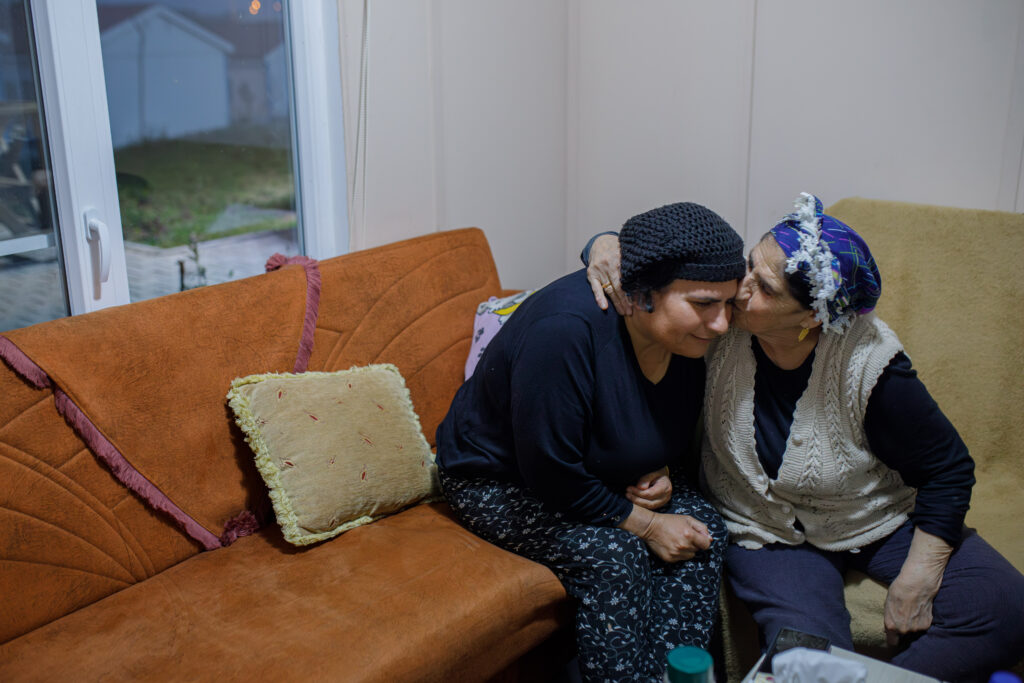
The desperate mood seen in their cramped living quarters is reflective of the almost 700,000 other people living in temporary shelters across what’s today called “the quake zone.” According to Hatay’s governor, Mustafa Masatlı, nearly 200,000 people live in “container cities” in Hatay alone. Thousands more are living in plastic tents, which you see set up on side streets and in the yards of cracked houses.
“My children can’t shake out their energies,” a distressed 31-year-old Yazgın Danışman says. “They don’t sleep at night. Their sleep and eating schedule is messed up.”
Danışman is a tired mother, housewife, and survivor, who lives in a container with her husband and three of her children. As we speak, she tries to soothe her 1-year-old to sleep in her lap. She is upset with the government for not keeping them safe against the earthquakes by promoting rapid gentrification, and for only acknowledging their hardships prior to the elections, when it could benefit them politically. “I will not vote,” she says, referring to the local elections on March 31. Her newfound friends—her neighbors—share her fury and resolve. They say they don’t want to “have to wait in these [containers]” for an unseeable future.
Still, it remains unclear just how much longer they will be trapped there. Before last year’s presidential and parliamentary selections, President Erdoğan initially vowed to totally solve the housing problem by “constructing quality and safe structures” for all affected by the earthquakes within a year. When he spoke again in August, the number was reduced to 319,000 safe new homes to be built—again, “in a year.” So far, he has only been able to deliver 46,000, according to the Environment and Urbanization Minister Mehmet Ozhaseki.
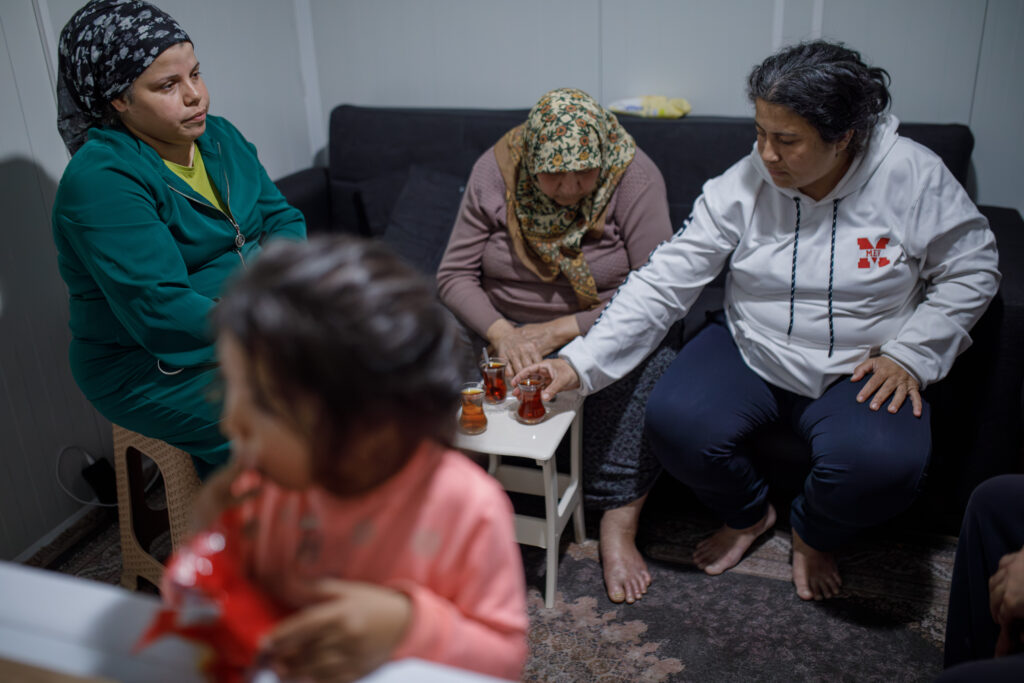
Critics, including the Union of Chambers of Turkish Engineers and Architects (TMMOB), have accused the government of favoring political motivations over sustainable solutions in this crisis, and have pointed out it’s making unrealistic promises to the public. Many citizens, meanwhile, blame the government not only for their lack of response to the tragedy, but for directly contributing to the extent of the damage in the first place. Although officials, including President Erdoğan, have repeatedly described the earthquakes as “the disaster of the century,” attempting to pin responsibility on divine forces, scientists suggest it was in fact the corruption and greed of local and central governments that killed the masses. Turkey had been expecting an earthquake of this magnitude for well over two decades, yet the government continuously moved forward with building projects that lacked the proper techniques, inspections, and planning to withstand the inevitable disaster. One notable example is the 2018 zoning amnesty granted by the Erdoğan government ahead of the elections, which condoned many illegal structures in a highly seismic country—a move seen as a way to gain votes over his opponents. In another case, the mayor of Hatay, a member of the main opposition party, received $200,000 worth of bribes to allow a lush apartment complex to be built three years before the earthquakes, only for it to collapse, killing more than 60 residents.
It would be one apartment complex of thousands: Lale Korkmaz, 50, lost both her husband and her 22-year-old son, Isa Baris, when their building collapsed, its foundations failing against the 4:17 AM earthquake. At the time, she had been at the hospital with her 26-year-old daughter, Buket, who was being treated for leukemia; Isa had been her marrow donor.
Buket would lose her life just one week after Korkmaz lost her husband and son. But, she says, Isa had been her daughter’s support system until the very end—not just as a donor, but as a poet, a vivid storyteller, and a bright spirit.
“He loved the Beatles; we would watch movie after movie,” Korkmaz says, her eyes tearing up. “We even had a WhatsApp chat that included only us three. One of us would message to let them know when the coffee was ready. I just really miss our conversations.”
Now, Korkmaz lives with her older daughter’s family in one of the prefabs, mounted by a private Turkish company and given to the government’s emergency and disaster management agency, AFAD. “[My granddaughter and I] blow kisses at the stars when they stand aligned,” she says, in hopes that her two late children are on the receiving end.
Korkmaz finds a small sliver of solace in her daily coffee dates with other women neighbors, each going through their own tragedies. She also holds out hope that a hospital somewhere will name one of its rooms after her daughter, and that the purple tulips she’s planted in her honor will bloom in the near future. That’s what her daughter’s name means—tulip.

But besides these brief moments of peace, the future is bleak both for her and for millions across the deprived quake zone, and in Antakya’s case, it is especially horrific. Prior to the earthquakes, it had been known around the globe as a culture and gastronomy hub, and as a prime example of coexistence, with Sunnis, Alewites, and multiple different Christian communities all living in harmony. Now, the earthquake’s name is all over the wrecked city, first called Antioch in the Bible, its many unique historic heritage sites almost totally wiped out.
Today, the city is so dusty, you see tired people covering their noses and mouths as they walk amidst what seems like a doomsday plateau. You can physically see the high risk of asbestos in the layer of dust that gathers on your clothes and your car. Out of 911,000 apartment units and homes, more than 266,000 were destroyed or severely damaged in Antakya, according to Mayor Lutfu Savas. The city feels like a giant construction zone, with excavators still scooping away mountains of rubble that once stood as buildings made of feeble concrete, some of which had been approved to be mixed with sand, per court documents. Where the rubble has been cleared, large patches of empty land remain, haunting locals while silently breaking their hearts.
But while everyone suffers deeply in Antakya, for women, the toll is even heavier, according to Canan Gullu, president of the Federation of Women’s Associations of Turkey, who’s been traveling between the quake-stricken provinces over the past year to implement various projects focused on helping women.
“Turkey already ranks very low on the Gender Gap Index,” Gullu says, referring to the 2023 World Economic Forum report, which puts Turkey at 129 out of 146 countries. “So, we are seeing this divide deepen further here now.”
Part of the problem is the lack of space, leading to pressure cooker domestic situations. “Imagine a life that fits 21 square meters [or about 225 square feet],” she explains, referring to the containers. “Women lack their private spaces. In that tightness, women are expected to cook, do the laundry, look after the children, serve the rest of the family.”
She has called for immediate psychosocial rehabilitation in the region, and for more training and employment options for women. The federation has also opened 30 “Purple Sites,” containers among the temporary settlements, where women can meet with psychologists, midwives, and child education specialists. They are seeing a rise in the number of girls dropping out of school, girls and women forced into marriage due to economic reasons, and of child abuse, Gullu says. “Children must be able to go to school or kindergarten,” she urges, noting that educational costs remain sky-high. She has also called for the government and private funding to help bring small businesses back on their feet as quickly as possible to help alleviate this, but there is a long way to go.

Turkey’s crippling inflation rate stands at around 83 percent, independent economists say. And in Hatay, many items are more expensive than ever due to lack of resources. According to the Treasury and Finance Minister, the cost of the damage from the earthquakes stands at $104 billion US dollars; but so far, only around $30 billion has been spent. And the clock is ticking for female freedoms under these destitute conditions.
“We are up against a tremendous increase in cases of violence, as well, because of poverty and unemployment,” Gullu says.
Aysel*, who asked to remain anonymous for security reasons, has experienced this firsthand.
“He beats me all the time, for any reason,” she says, referring to her abusive husband. She says she married him when she was 48, and that he has been violent throughout their marriage, choosing to spend almost all of their retirement stipend on drinking all day. But after February 6, her life only got worse.
“I want to get out,” Aysel says. “I built a little hut, and I’m going to move there, and wait for him to divorce me.” She hopes he will have to pay her alimony if that happens.
Still, Aysel is afraid that he could track her to her new home, and assault her there, and is considering trying to get a restraining order against him—but is also scared of what might happen if she does. “He’s been sleeping with a knife under his pillow for the last two months,” she says, sobbing.
What Aysel has survived is heartbreakingly common in the region, even before last year. “According to the official data on domestic violence against women, available from prior to the earthquakes, the affected regions have a relatively lower rate of reporting to authorities and higher level of acceptance in cases of violence,” a recent UN Women report says. But Aysel is determined to get out.
Now over 60, she wants to start over, if she’s able to find the opportunity to do so. She hopes to begin working soon, but is worried about the lack of opportunities in the city, and knows she will struggle finding a job. “I’m willing to do any work just to stay away from him,” she says. Her resolve is reflective of many other women in the region, in spite of all that has been taken from them.
For hundreds of thousands—if not millions—of women and girls, the obstacles of the earthquakes’ aftermath stand tall, and brighter times lay too far out in the horizon to be seen. But without the government coming to save them, each will continue doing all that they can to persevere on their own.
